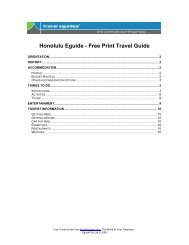Australia Eguide - Travel Guides
Australia Eguide - Travel Guides
Australia Eguide - Travel Guides
Create successful ePaper yourself
Turn your PDF publications into a flip-book with our unique Google optimized e-Paper software.
191<br />
Victoria<br />
In 1803, Lt. David Collins attempted, but failed, to found a settlement in Port Phillip Bay,<br />
where Melbourne now lies, and it was to be more than three decades before a further<br />
attempt was made.<br />
In fact, the first permanent settlement in Victoria was not in Port Phillip Bay, but at<br />
Portland in the extreme west of the state. Portland dates from 1834. Port Phillip Bay was<br />
settled in the following year, 1835, by John Batman and John Fawkner, who crossed Bass<br />
Strait from Van Diemen’s Land (Tasmania) in order to found the city which is now<br />
Melbourne. Unlike previous settlers, Batman and Fawkner made an attempt to purchase<br />
the land from the local aborigines. At the time, the government of New South Wales was<br />
trying to discourage settlement in outlying areas, but it was soon forced to recognise the<br />
existence of a community in Port Phillip Bay and to send administrators.<br />
The new settlement strongly resisted the introduction of convicts, although in the end<br />
some convict labour was used in the area. The settlers also requested, from an early stage,<br />
independence from New South Wales, and this was granted in 1851, when the new<br />
colony of Victoria was established.<br />
It was at this point that gold was discovered in Bendigo, Ballarat and several other<br />
locations in Victoria, and the finds included the largest known nuggets in history.<br />
Suddenly Victoria became rich. The population of the state trebled and the new-found<br />
prosperity endured for a period of thirty years, manifesting itself even now in the form of<br />
some magnificent public buildings, both in Melbourne itself and in the gold towns.<br />
When the gold ran out in the 1890s, a period of economic depression followed, but<br />
Victoria was already so well established that Melbourne was chosen in 1901 as the venue<br />
for the temporary capital of the new Commonwealth of <strong>Australia</strong>.<br />
In the 1950s, Victoria became a great centre for immigration, particularly by those from<br />
Italy and Greece, and Melbourne was hailed as the third largest Greek city in the world.<br />
The city still retains a great cosmopolitan flavour reflected particularly in its cuisine and<br />
in its corner shops.<br />
Victoria is the smallest mainland state, with an area of 227,420 square kilometres. Only<br />
Tasmania and the <strong>Australia</strong>n Capital Territory are smaller. In terms of population,<br />
however, it is the second most populous, after New South Wales, with a population of<br />
approximately five million, which is to say that this small state contains a quarter of the<br />
total population of <strong>Australia</strong>.<br />
Only the <strong>Australia</strong>n Capital Territory is more densely populated. In fact, though, as in<br />
other states, two-thirds of the population lives in the capital city. As soon as one leaves<br />
Melbourne it is difficult to believe that this is <strong>Australia</strong>’s most densely populated state.<br />
Melbourne itself is an attractive and interesting city and its trams clattering through the<br />
streets give it a sense of individual character greater than that in any of the other capitals.<br />
It also offers a line of pleasant beaches stretching round the bay. Outside the big city, the<br />
Free from <strong>Travel</strong><strong>Eguide</strong>s.com Online <strong>Travel</strong> Information.<br />
©2008 <strong>Eguide</strong> Pty Ltd




